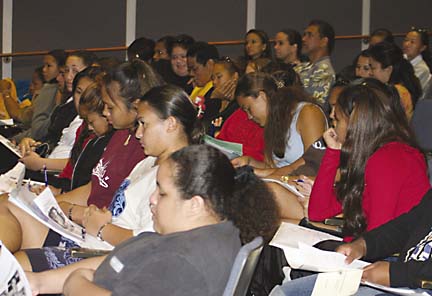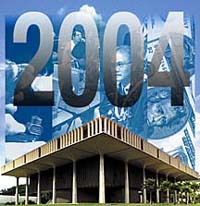
COURTESY PHOTO BY NAOMI SODETANI
Hawaiian-focused charter schools are pushing for a bill that would create a separate school district. Hawaiian charter and immersion school students listen to speakers at an education reform briefing hosted by Council for Native Hawaiian Advancement at the state Capitol last week.
Hawaiian school
bill advancesThe measure allows Hawaiian-oriented
charter schools to have their own district
Hawaiian-focused charter schools scattered across the state are pushing to create their own school district in hopes of forging stronger links and attracting more funding.
A bill allowing a five-year pilot project for such a district passed the Senate unanimously last week and was on this afternoon's agenda of the House Education Committee.
"The statistics clearly show that Hawaiian children are left behind, and this will afford us an opportunity to initiate systemic change for Hawaii's native students," Ku Kahakalau, founder of Na Lei Na'auao, the Native Hawaiian Charter School Alliance, said yesterday. "It's not the answer, it's a beginning to solve the problem."
Hawaiians are the largest ethnic group in the public schools, representing 26 percent of enrollment this school year, Department of Education data shows. But they fall at the bottom in test scores, and are less likely to graduate than their peers, according to a June 2003 study by Kamehameha Schools.
Star-Bulletin Legislature Database
Star-Bulletin Legislature Guide
(PDF, 2.4 MB)
State Legislature: Bills
& Hawaii Revised Statutes
"To have any kind of educational reform that doesn't focus on Hawaiians is poho, a waste of time," said Kahakalau, who is also principal of Kanu o Ka Aina charter school on the Big Island.
Senate Bill 3148, sponsored by Sen. Colleen Hanabusa (Nanakuli-Makua), originally focused exclusively on charter schools that are based on the "host culture," or Hawaiian language and culture. But at the request of the Hawaii Charter Schools Network, it was amended to allow other charter schools to launch a similar pilot project with their own district.
About 4,500 students attend Hawaii's 26 charter schools, roughly 2 percent of the public school population. Twelve of those schools are based on Hawaiian cultural values, with more than 1,000 students enrolled, mostly of Hawaiian ancestry.
Charter schools are public schools with their own school boards. They are exempt from most state regulations, and are supposed to serve as models for innovation and personalized learning.
Although such schools have some autonomy from the Board of Education, the legislation takes it a step further. The bill calls for a district council to represent and monitor the district's schools and submit their budget request to the Legislature separately from the Department of Education. The council would be appointed by the governor from nominations by the charter schools and the department.
The pilot district could share resources among schools, form partnerships with the private sector, and qualify for more federal funds.
"All they're asking is 'recognize us so that we can continue to help ourselves,' which I think is the best scenario," Hanabusa said. "It's the next step. They've shown us they can succeed."
"Many of these students have come forward and testified that under normal circumstances they would have dropped out," she added, "but they've become part of a family, part of a culture that encourages them, that they want to succeed in."
The pilot project would be evaluated on various factors, including test scores, parental involvement, fiscal measures, and whether there is any discrimination or segregation in the district.
"Rather than subjecting the entire Department of Education to radical, unproven changes, the host-culture district can pilot school-based budgeting and true community control of education, and educate officials on the viability of decentralization and local involvement," Kahakalau said.

